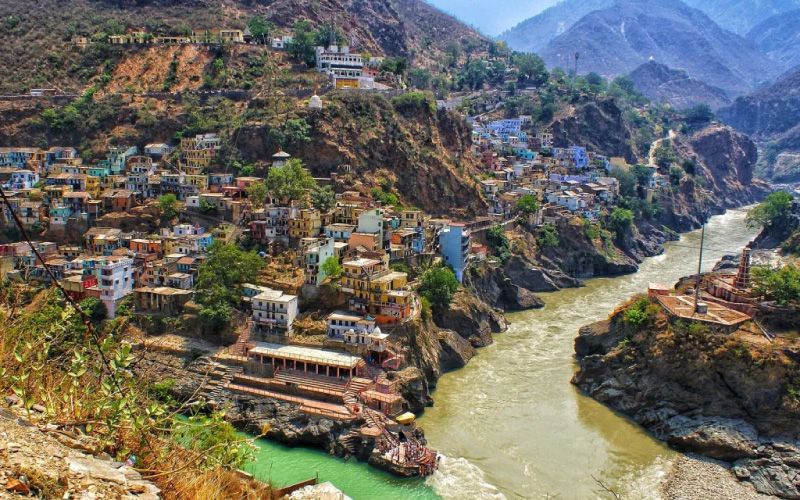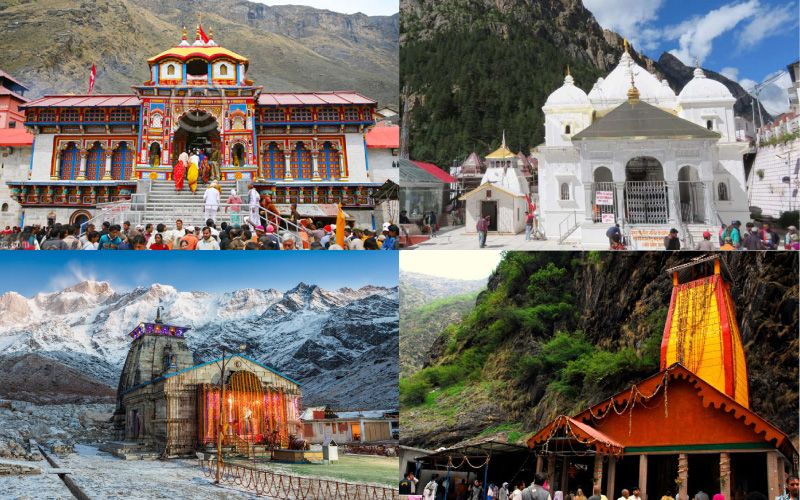
Chote Char Dham in Uttarakhand Invite You To The Hindu Pilgrim Destinations in the Himalayas
Chhote Chaar Dhaam as the words suggest, they mean, 'Four Small Abodes'. These four most important Hindu pilgrimage centres are situated in Uttarakhand(in the Garhwal region of Himalayan ranges).
When we go as per the Hindu religion, it says that the ‘Char Dham Yatra’ is a sacred trip of four most revered temples of India which includes Badrinath, Dwarka, Puri and Rameshwaram.
But here we are talking about the 'Chhote Chaar Dhaam of Uttarakhand' so we must keep in mind that the circuit of ‘Chota Char Dham Yatra’ is different from main Char Dham Yatra and is situated only in Uttarakhand.
This pilgrimage of the four sacred temples or sites or shrines of Hindus in Uttarakhand is named as Yamunotri, Gangotri, Kedarnath & Badrinath respectively. These four temples are situated in four different directions of Uttarakhand and are devoted to different Gods and Goddesses.
Chota Char Dham Yatra is one of the most popular pilgrimage routes, which is undertaken by a lot of devotees each year with the hope of eliminating all sins to attain salvation by the blessings of the Lord.
In fact, devotees visit these shrines not only from India, but also there is an immense growing popularity among foreign tourists too. They visit out of curiosity or to learn more about Indian culture.

Let us now begin with the History of these abodes or Dhaam one by one.
1. Yamunotri
The temple at Yamunotri is dedicated to Goddess Yamuna. One important point to observe is that the main Deity of the temple is made up of Black Marble. It was built in the 19th Century by Maharani Gularia of Jaipur.
The original temple was destroyed in a climatic activity, and the present temple was rebuilt at the same place. Also, the Yamunotri Shrine was originally constructed by Maharaja Pratap Shah of Tehri Garhwal on the left seashore of Yamuna River.
2. Gangotri
As Hindu Mythology states, Ganga was born as a result of a blessing given by Lord Shiva to King Bhagirath for his penance. However, owing to her superiority as well as the fact that Earth would be overwhelmed if Ganga came down in full force, Lord Shiva caught her in his locks.
It is said that there is a sacred stone near the Gangotri temple which denotes the place where Ganga first came down to Earth in the river form. That is why Ganga is also called by the name of Bhagirathi (i.e. the daughter of Bhagirath).
The Gangotri temple in its present form was constructed by Gorkha Commander Amar Singh Thapa in the 18th Century. It is believed that at the time of construction of the current temple, the Gaumukh glacier was present here. However, it has receded to its current location due to global warming and climate change.
3. Kedarnath
It is dedicated to incarnations of the Third Eye Lord. Kedarnath is named after King Kedar, a ruler from Satya Yuga. This is the place where Lord Shiva is said to have liberated the Pandavas from killing their own cousins, Kauravas in the Mahabharata.
In fact, there is an interesting story behind the town and its temple. According to the Puranas, the Pandava brothers did a major penance in Kedarnath to please Lord Shiva.
Another legend of the Kedar temple states that Goddess Parvati worshipped Kedareshwar to unite with Shiva as Ardhaanareshwara.
Earlier, the temple was built by Pandavas. The present-day temple was built by Adi Shankaracharya. Just behind the temple, the samadhi of Adi Shankaracharya can be found.
4. Badrinath
The name of Badrinath Temple has originated from the local word Badri which means a type of wild berry. It is the abode of Lord Vishnu.
The original Badrinath temple was built by Adi Shankaracharya, who initially discovered the Badrinarayan idol in the Alakananda River. It was he who moved the shrine into the hot water springs of Tapt Kund.* Due to natural time taking the course, there was a need for a new temple to be built.
The Present temple was built by King of Garhwal in the 16th century. The stunning ornament stones, traditional carving, pillar designs will take your breath away at the first look! In terms of the architecture, the appearance is similar to the Buddhist Vihara temple.
(*Tapt Kund is the abode of Lord Agni and is famous for its medicinal properties. Before entering the Badrinath Temple, one has to take a holy dip in the Tapt Kund. The dip into the hot water of this kund is believed to be spiritually rejuvenating and relieves the sins.)

This covers the main history of the Chhote Chaar Dhaan in Uttarakhand. Now, a brief about their religious significance of the chhote chaar dhaam.
1. Yamunotri
Goddess Yamuna to whom the Yamunotri temple is dedicated to is considered as a holy mother figure by her devotees. All Hindu devotees strongly believe that by visiting Yamunotri temple, by praying at the feet of Goddess Yamuna, by getting the privilege to taste the holy ‘Prasadam’ and by taking a holy dip in the River Yamuna, they would be able to dissolve all their mortal sins and get free from the ‘fear of death’.
It is a tradition in the temple to cook ‘Prasadam’ from the water of adjoining hot springs. The fuming hot spring water can easily help in cooking rice, pulses and in boiling vegetables. This food is offered to the deity as ‘Prasadam’ and also distributed among devotees. Devotees consider this mineral-enriched Prasadam to be very holy and soul-liberating.
2. Gangotri
The religious significance of Gangotri could be associated with its many mythical connections. It is believed that the waters of River Ganga flowing at Gangotri contains in it powerful nectar by means of which Lord Shiva’s throat was soothed and healed after he had gulped poison.
Pilgrims strongly believe in this and thus come in large numbers from far to carry back with them the holy waters of River Ganga which is then used for worshipping Lord Shiva.
3. Kedarnath
The importance of the Kedarnath temple is visible with the growing number of pilgrims that heads towards the holy site every year. It shows the presence of one of the 12 Jyotirlingas of Lord Shiva. The temple contains a ‘Garbha Griha’ which is meant for worship and a Mandap that is designed for assemblies of visitors and pilgrims.
Visitors and pilgrims visit the Kedarnath Temple with the purpose to enlighten their poor souls with the luminous cosmic light that resides in the form of conical rock shaped formation which is worshipped as Lord Shiva in the form of Sadashiva. People who visit the temple believe that this visit will grant them the staircase to attain moksha from all their sins.
4. Badrinath
There are some significant factors which hold the importance of visiting this shrine. In Bhagwad Gita, the surrounding area of Badrinath is called as Badari which was a location holy to Vishnu. The sacred Alaknanda Lake, which is nearby Badrinath Temple is very popular among religious tourists and holds significant religious importance.
It is believed that Goddess Ganga was asked to come down to Earth for the benefit of humanity, but Earth was unable to bear her descent, and Ganga was split into twelve sacred channels, Alaknanda being one of them. It is also believed that Lord Vishnu used to meditate here while Goddess Lakshmi used to shelter him from the sun by standing next to him.
She turned into Badri called ‘BADRI VISHAL’ and Lord Shiva became the Badri-Nath (Lord of Nath).In the religious scriptures of Padma Purana, the surrounding area of Badrinath is famous for housing holy possessions.
So dear readers, this was some major history related to Chhote Chaar Dhaam in Uttarakhand, as well as their religious significance. Hope this will be helpful to convince you to visit these abodes in the peaceful Himalayas at least once in your lives. It is going to be a one time experience, giving you the peace and harmony you need.
Read More:
- The Char Dham Yatra Offers Closest Experience of God and Peace
- 5 Facts About Ravana That Show The Other Side Of The Demon King Of Lanka
- 9 Navratri Devi Names and Importance of Each Day of Nav Durga
- 10 God Vishnu Avatars That Are Known As Dashavatara of God Vishnu
- 12 Jyotirlingas in India With Temple Names, Location And Details
Explore: Feeding Trends | Events
Appreciate the creator